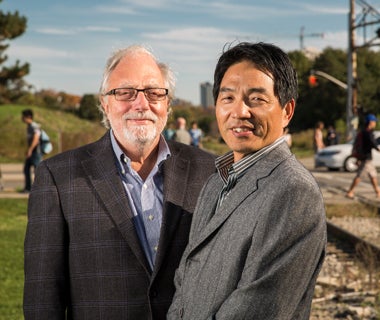
Waterloo research makes railway crossings safer with science
Engineering prof leads work into software program that ranks the safety of Canada’s railway crossings

Engineering prof leads work into software program that ranks the safety of Canada’s railway crossings
By Bob Burtt Communications and Public AffairsMaking sure people are safe at a railway crossing involves considering everything from the condition of the road and railway, to accident history and speed of the traffic and trains.
 Liping Fu and Frank Saccomanno, Waterloo engineering professors, together with their students have developed a unique web-based software program called GradeX that is taking the guesswork out of safety at railway crossings.
Liping Fu and Frank Saccomanno, Waterloo engineering professors, together with their students have developed a unique web-based software program called GradeX that is taking the guesswork out of safety at railway crossings.
“Transport Canada makes a huge investment every year in railway crossings across the country and they want to make sure decisions are based on science,” says Fu, a professor in the Department of Civil and Environmental Engineering.
Web application assesses danger
GradeX is a web application that his research team has developed over the past decade to assess danger at over 30,000 rail crossings in Canada and to rank them according to the risk.
Transport Canada collects information about the condition of roads or highways where railways cross. They look at the condition of the pavement, traffic, sightline, speed, and other factors that affect safety.
“We take that information and run it through GradeX which gives us the rankings,” says Fu. GradeX is available on a website and is easily accessible to engineers who need the information.
Once officials know which crossings should receive attention first, they can look at which safety countermeasures would give the biggest bang for the buck. Some of the corrective measures could include signage, installation of gates, lights or, in extreme cases, a grade separation.
Ottawa fatalities
Fu hopes to begin work on a two-year, $120,000 project that will help Transport Canada improve GradeX and identify even better ways to assess potential dangers at crossings.
Last month, six people were killed and 30 injured in Ottawa when a bus crashed through a safety barrier and into a Via train. Fu said discussion about his study was in the works long before the accident.
He said there is no way of knowing whether using a tool like GradeX might have been able to prevent the Ottawa accident, but he noted the overall goal is to make crossings safer and reduce the number of rail-related accidents.
In the past, Fu has done work for the Ontario Ministry of Transport and Transport Canada and is a member of many technical committees of various professional organizations, including Transportation Research Board based in Washington D.C.. He was a past Chair of Transportation Division of Canadian Society for Civil Engineering and a recipient of Transportation Association of Canada (TAC)'s 2011 Academic Merit Award sponsored by Transport Canada for his long-term contribution to the advancement of the academic field and to the development of tomorrow's transportation leaders.

Read more
The University of Waterloo will be a key partner with leading Canadian companies and sectors chosen to help grow our country’s global competitiveness through significant investments in the areas of artificial intelligence (AI) and advanced manufacturing

Read more
Building an artificial brain that will one day replace human drivers is an incredibly complex technical challenge, say the researchers leading Waterloo’s autonomous vehicle project

Read more
New building will house research on machine intelligence, mobile robotics, autonomous vehicles and wearable biomedical devices
The University of Waterloo acknowledges that much of our work takes place on the traditional territory of the Neutral, Anishinaabeg, and Haudenosaunee peoples. Our main campus is situated on the Haldimand Tract, the land granted to the Six Nations that includes six miles on each side of the Grand River. Our active work toward reconciliation takes place across our campuses through research, learning, teaching, and community building, and is co-ordinated within the Office of Indigenous Relations.